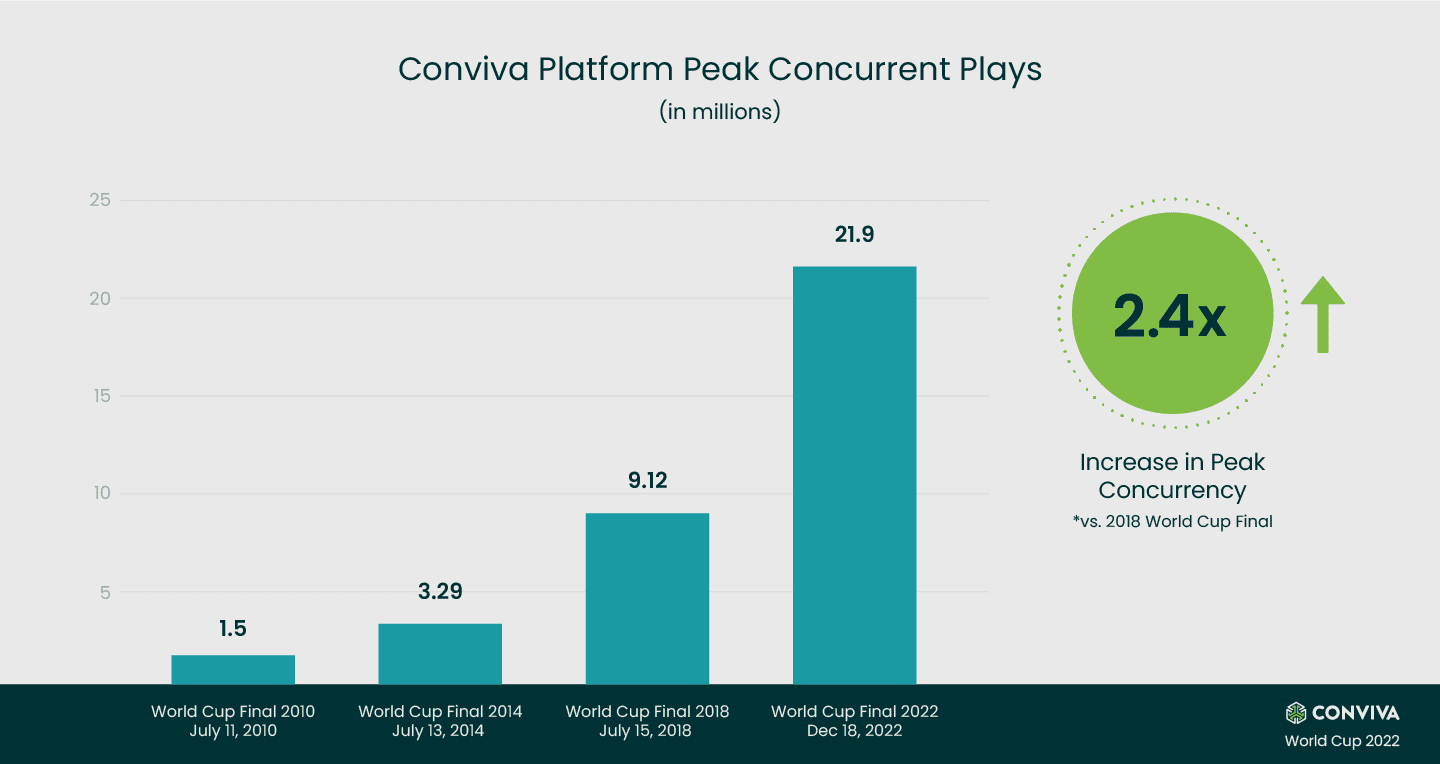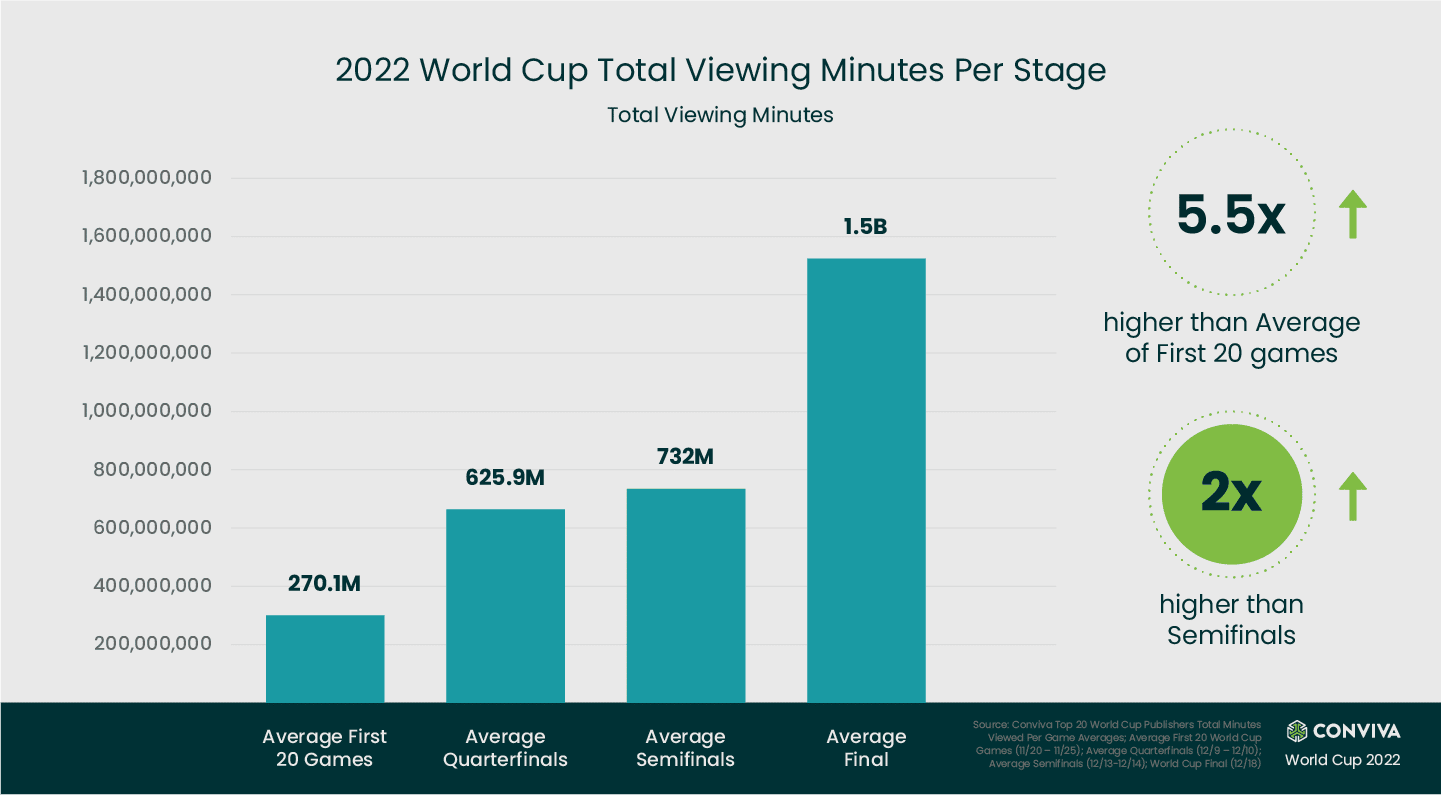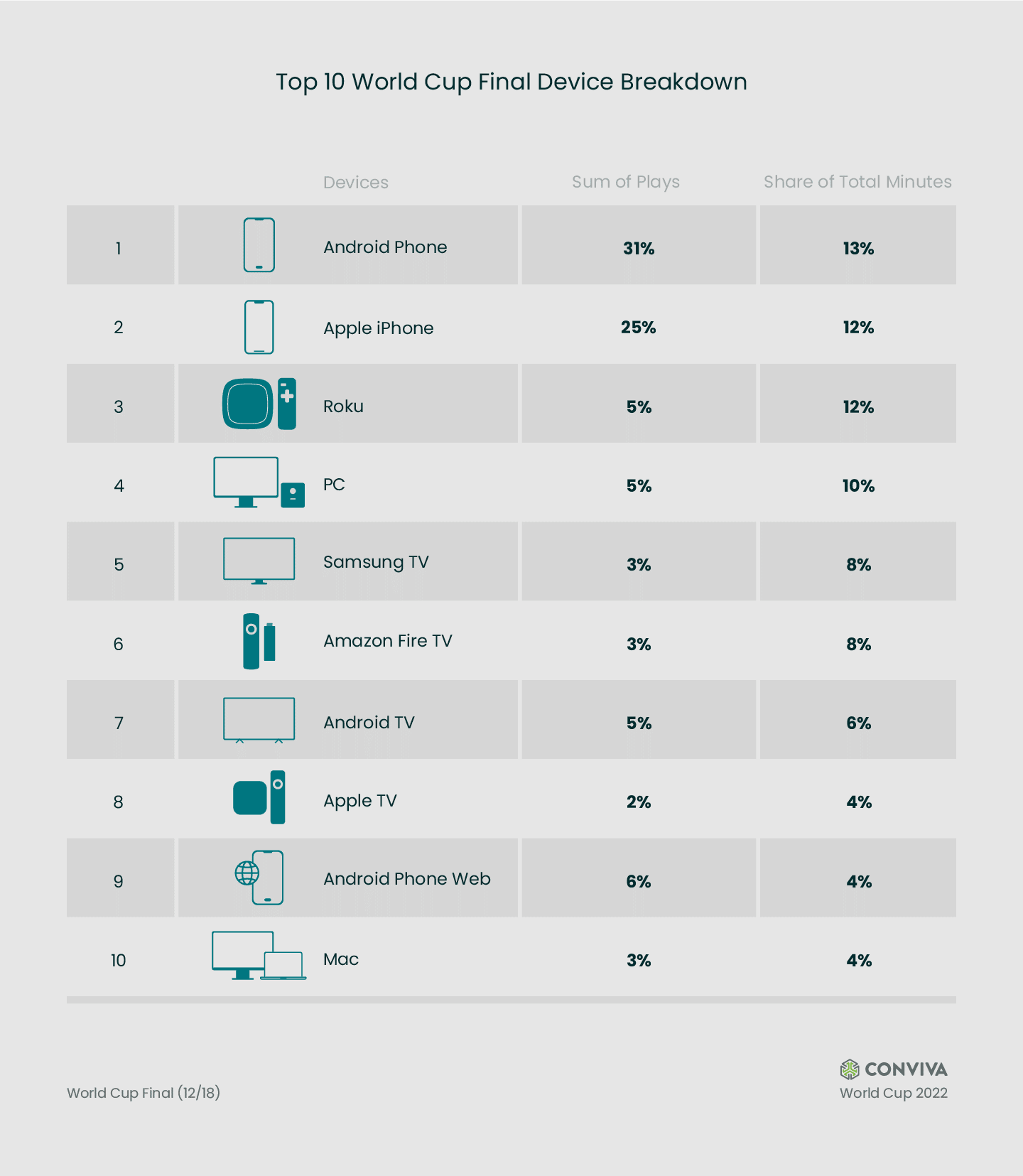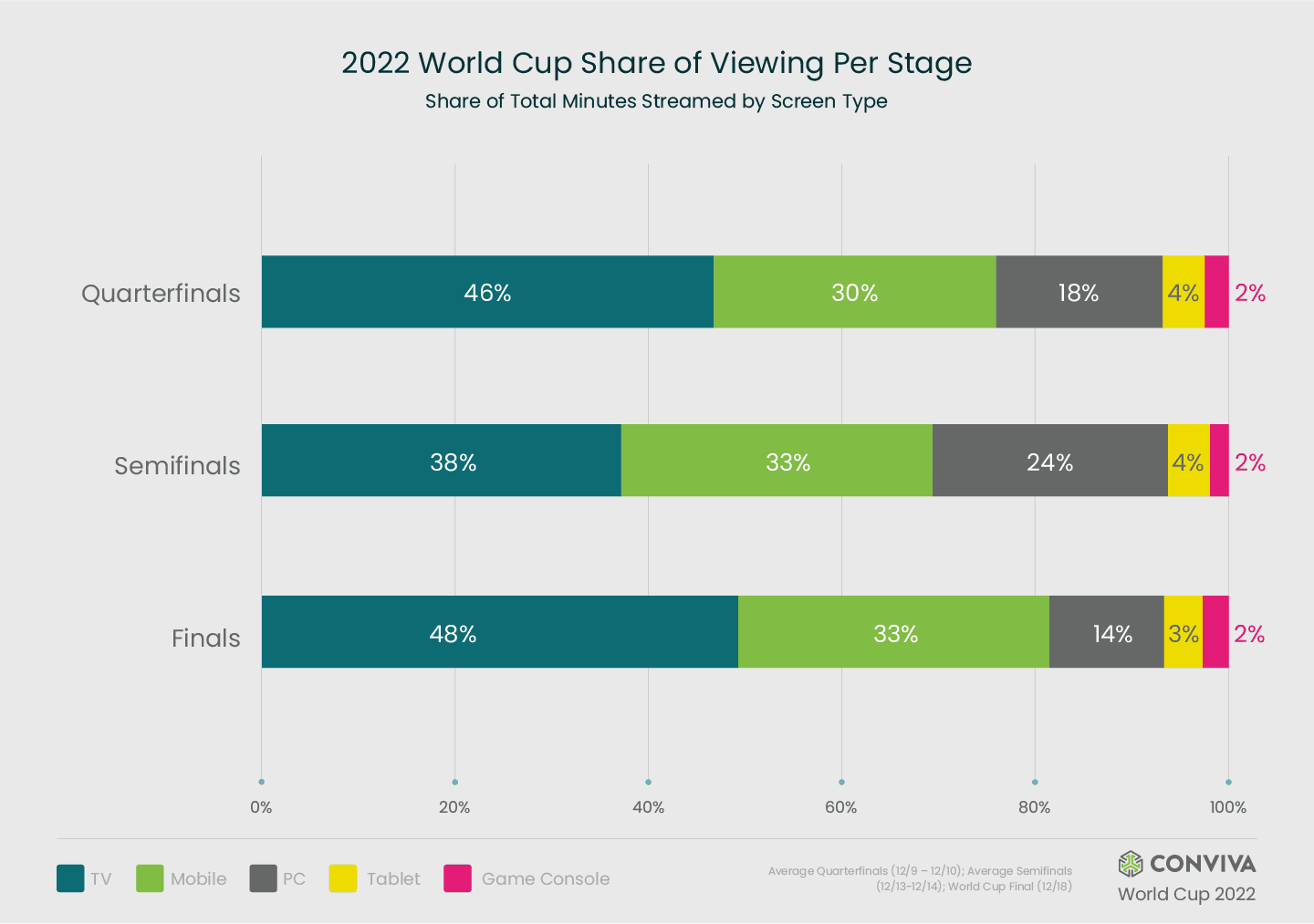Given the growth in live sports streaming, industry watchers were eager to see whether the experience measured up for fans of the 2022 FIFA World Cup. Expectations from those who have adopted live streaming as their preferred way to view their favorite matches were high. And they didn’t care about the complexities of live streaming one of the world’s largest sporting events – on a global scale, for weeks on end. They just wanted to be part of the action as it happened.
With no do-overs, publishers entrusted to bring the World Cup to their audiences were under enormous pressure, especially with the plethora of new technological challenges emerging as traffic volumes increase. And, while some services did let fans down, the 20+ publishers Conviva worked with all delivered optimal viewing experiences throughout the 29-day event. They used Conviva’s streaming media analytics platform for real-time continuous measurement and monitoring of dozens of metrics, like video quality, viewer engagement and network performance. The platform also enabled tech ops teams to anticipate and respond in real-time to service, performance and reliability issues, and take immediate action during active viewer sessions to deliver the best experience on any screen.
In other words, the excitement on screen was often matched by that behind the scenes. While records were being broken on the field -a total of 172 goals were scored over the 64 matches, besting the previous record by one point; Cristiano Ronaldo became the first man to score at five FIFA World Cups; the first all-female team refereeing at a men’s FIFA World Cup match – we also saw record-breaking streaming viewing audiences. And together with our customers, we were ready for them.
While any live streaming event requires a maniacal focus on the event itself, we know from experience that preparation, modeling and forecasting are equally important. For over a decade, Conviva has been the trusted partner to the largest streaming publishers, powering the most complex, prestigious live streaming sporting events. We take pride in helping our customers set new standards for what great live streaming looks like. And that goes beyond four consecutive World Cups, to include the Super Bowl, the Olympics, NCAA March Madness and more.
With more than 20 customers streaming this year’s World Cup, we were once again in a unique position to observe, aggregate and analyze trends and behaviors that speak to both the present and future of live sports streaming. And, like the matches themselves, what we saw this year did not disappoint.
Record-Breaking World Cup Viewership
With fans anxious to see if football legend Lionel Messi would capture the ultimate prize in the sport or if Kylian Mbappe would become a back-to-back World Cup Champion, Sunday’s high-stakes match between France and Argentina was likely the biggest live stream sporting event the world has seen. Conviva measured a record-breaking 21.9 million Peak Concurrent Plays (calculated as the highest number of active viewers at any point during the match) across our platform, making it the highest streamed event in the 4 World Cup contests we have measured since 2010.
Football fans were locked in for every second of that nail-biting finish, as viewership peaked in the last minutes of the Finals match when the game went to penalties to decide the winner. In total, Conviva measured a 537% increase in total minutes streamed from our top 20 customers in this 2022 World Cup Finals match compared to the 2018 Final. With the extra time on the clock and the penalty shoot-out, we also measured a higher average watch time than any other match in this year’s World Cup tournament: an average of 55 minutes per unique device.

Conviva tracked viewership across every stage of the tournament. We identified that totaliewership is naturally higher for the World Cup Final than the Group Stage matches. Such a stark increase in total minutes viewed reflects not only the levels of excitement around this final game, but also indicates that viewer experience was not impacted by the increase in traffic volumes. This was a win for Conviva and our customers.

A Big Game for Advertisers
Thanks in part to record-breaking viewership, the 2022 World Cup Final also helped advertisers around the globe connect with their target audiences. Conviva tracked over 5.3M concurrent ad impressions and more than 125M total ad impressions over the course of the match. Since this was one, advertisers that strategically leverage streaming platforms saw a particularly healthy ad reach and publishers saw record-breaking ad revenue.
But measuring ad performance for live sporting events doesn’t stop with impressions. It’s essential for advertising teams to also measure the engagement and overall Quality of Experience associated with their ads to ensure effective ad delivery at such a large scale. This requires granular, viewer-level insights to understand ad load, rebuffering, ad start failure, and a multitude of other quality-based metrics that can impact the overall efficacy of an ad campaign. The experience a viewer has while watching the entirety of a match can impact how they engage with ads during breaks. It’s therefore crucial for publishers and advertisers to collaborate to ensure Quality of Experience is consistent for every second of a live stream.
Mobile v. TV: The Battle Continues
Twenty-four million unique devices tuned in to the Final match.was diverse, creating a challenge for publishers to deliver a high-quality experience across a wide range of devices. Mobile devices accounted for more than half of total plays, while overall minutes viewed were much more dispersed across device types.
Despite the breadth of device usage, Conviva did not measure significant decreases in Quality of Experience across devices. This was exciting given mobile devices can pose additional challenges to effective content delivery. The variations in Internet speed, data access, and device capabilities are all contributing factors. That is why we encourage publishers to focus on device-specific optimizations and drill down into granular issues that may only impact a subset of devices. With an event like the World Cup viewers tune in no matter where they are, so it’s crucial that every device delivers an optimal viewing experience.

More viewers opted to watch the Final on a big screen compared to earlier stages in the tournament in which PCs and mobile devices were more popular, especially during weekday matches. It wasn’t surprising that fans, eager to watch the dramatic finish to an exciting few weeks of football, naturally wanted to watch on the biggest screen available.

While the global average for mobile streaming generally is nearly 11.3%, over 30% of viewers watched the final match on mobile (source: Conviva Q2 2022 State of Streaming). The proliferation of mobile devices has made it easier for viewers to tune in wherever they are, but we have yet to see fans watch most of a match on smaller screens. Large screens still rule— the average play duration on big screens is nearly 4x longer compared to that of mobile phones. Fox Sports reported nearly 3x more mobile app downloads (6.6M) compared to their living room app (2.5M), up 21% from their Russia 2018 total installs.
As accessibility of live sports continues to drive people to tune in wherever they are, we advise streaming publishers to adapt as well, and develop strategies to deliver live mobile streaming.
The Future of Live Sports is Streaming
Streaming live sports is here to stay. The World Cup was exciting evidence of that and a milestone for live streaming sporting events and for Conviva. While Argentina basks in the glow of victory, we can expect the transition to streaming for all live sports to accelerate and streaming providers participating will need to be prepared.
Conviva has invested decades of work to ensure our customers can deliver spectacular viewing experiences. Our deep live streaming analytics history informs how we continue to execute a gold standard in live streaming sports. Fortifying our own big data technology stack, ensuring our systems are always reliable, and preparing our customers months in advance for a large event (especially for events like the World Cup!) are all pro forma parts of our playbook now. We’re particularly proud that our systems experienced no data delays, decreases in system response times, or any major issues for any of our customers during this year’s World Cup.
We look forward to continuing to support all streaming providers as they adapt to the changing world of live streaming sports. Here are a few of the best practices in a changing live sports streaming world:
Be prepared to break records. As time goes on any publisher’s streaming peak concurrency will continually be broken. This requires systems to be evaluated holistically prior to every event. Streaming providers need to size up all their systems and their vendors’ systems based on a forecast of new subscribers or viewership from their marketing organizations. This includes cloud providers, Content Delivery Networks (CDN), subsystems that provide content catalogue, subscriber management, other modules and measurement solutions.
Be prepared to address problems in real-time. With alerts and artificial intelligence, the right tools and technology can make the difference between a good or great (and avoid poor) viewing experience. Having real-time alerts increases the ability to respond quickly to any issues that arise. It decreases the cost of responding and improves the overall customer experience. It’s crucial to have access to an incredibly deep level of streaming data in real time, so technical teams can drill down, uncover root causes, and solve issues quickly. A single minute of play can be consequential to the outcome of a game. Streaming providers can’t afford interrupted service or poor video quality that disrupts the viewing experience.
Anticipate changes in behavior for appointment viewing. Standard benchmarks for mobile traffic vs CTV vs Smart TVs don’t hold up for live events. Viewers engage in different viewing behavior for live sporting events and systems should adjust network resources to support anticipated traffic and scale wherever it is needed. We have the same responsibility to our customers, always ensuring our systems and technology are ready to support any scale.
Expect the unexpected. As the adage goes, “I can’t fix what I don’t know is broken.” Working with an experienced real-time streaming media analytics platform, will give you the biggest view of your streaming data and a heads up on the types of problems that can occur during a live event.
This World Cup provided a glimpse into what streaming has to offer live sports. If you’re preparing for a large, live streaming sporting event, learn how Conviva can provide crucial insights to help you deliver the highest quality streaming experience to every viewer.





